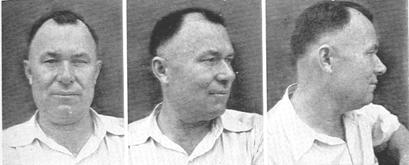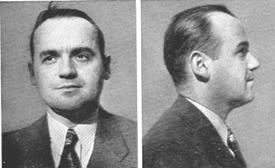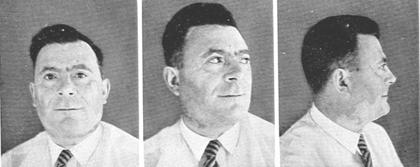|
(Photographic Supplement, Plate 14)
Alpines from Central, Eastern, and Southeastern Europe
East of Bavaria, Bohemia, and Switzerland, typical Alpines are relatively
rare until one reaches southern Albania and Greece; their northeastern limit
of frequency is the Carpathians, and between the Carpathians and the
Adriatic, they are usually found ina hybridized (Dinaricized) form.
FIG. 1 (3 views). Magyar from Pecas, Hungary. This tall Alpine from Hungary
is, except for his stature, as perfect an example of the Alpine race as
could be found; he may be compared to the Alpines on Plate 11, from Germany.
Hungary is ethnically a composite nation, and this individual's family has
traditions of both French and German admixture.

FIG. 2 (3 views). Ukranian from Novograd Bolynsk, in the Volhyn District.
Like many Volhynians, this individual is predominantly Alpine, although he
shows evidence of Atlanto-Mediterranean or Nordic admixture, or both. The
Volhyn constitutes in part an Alpine sub-nucleus to the northeast of the
Carpathians.

FIG. 3 (2 views, photo Marion Lambert). A Tosc from Katundi, southern
Albania. This man is as perfect an Alpine as the Hungarian on the preceding
plate, the Frenchman on Plate 12, Fig. 2, or the Germans on Plate 11.
Southern Albania forms an Alpine nucleus comparable to that in south central
France or Bavaria.

FIG. 4 (1 view). Another Alpine Tosc; in this case from Gjinokaster, in
the extreme southwest of Albania, bordering on Epirus.

FIG. 5 (3 views). A Greek from Sparta. The Alpine strain of southern Albania
extends down through western Greece into the Peloponnesus. In Greece it is
frequently blended with a local tall Mediterranean strain.

|




